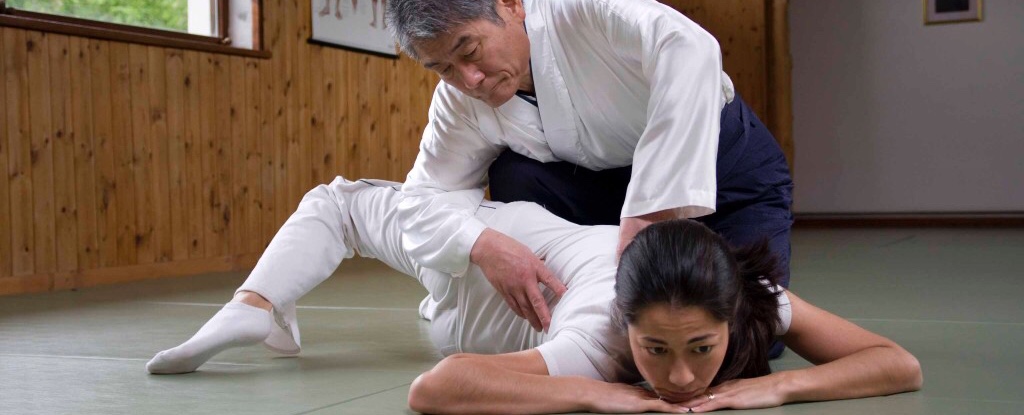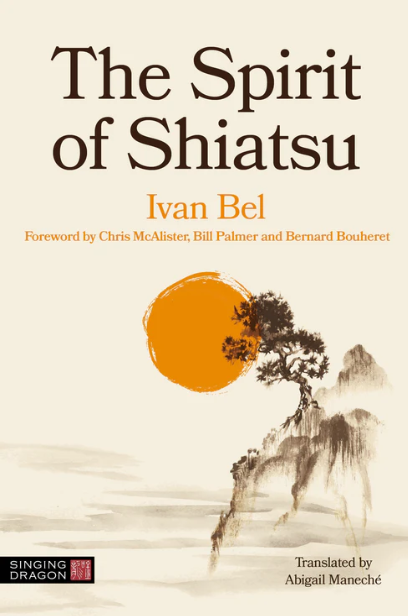Of the Japanese pioneers who introduced Shiatsu to Europe, Yuji Yahiro sensei is one of the most famous names who have influenced the entire Italian peninsula. His career reveals an unconventional personality drawn, from his young age, to develop a deep spirituality. It is thanks to this quest for spirituality that he has established bonds with giants such as Taisen Deshimaru, Masanobu Fukuoka, Shizuto Masunaga or Masahiro Oki. He has agreed to reveal himself to us in this superb interview in which he talks about his life, his Shiatsu and his endless quest to become “a true human being”.
Ivan Bel: Hello Sensei and thank you for taking the time to do this interview. Before we start, I would like to know how you are and whether your family is in good health.
Yuji Yahiro: Looking at me, what do you think?… If you are alive, it means that you are doing fine.
I usually start my interview with questions about people’s lives, but I can’t help asking you something that puzzles me right now. How is it that in your Shiatsu school you also have a Taiko school? That’s amazing!
Now our group is registered under the name “Okido Mikkyo Yoga Book University”.
In our place of study, we have 4 sections: Okido Yoga, Meiso Shiatsu, Naturopathy and the art of Munedaiko (the universal sound of the Japanese drum).
The Munedaiko group, whose founding members are my three sons, established its association on their own. It is recognized by the Japanese Embassy as a representative of traditional cultural art. Before joining forces and co-operating, each of my children traced their own path of research.
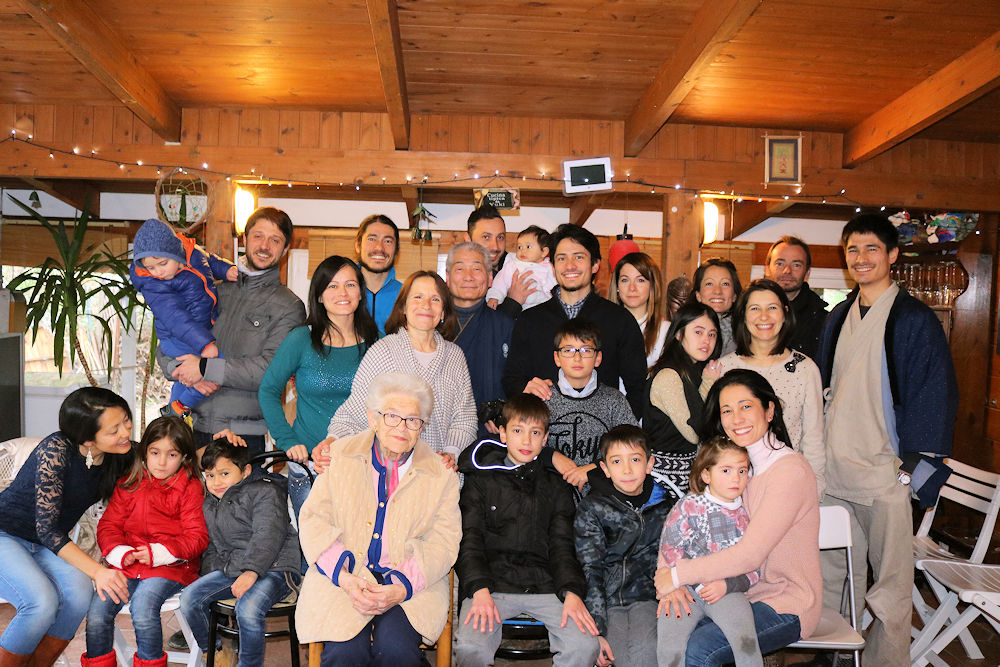
Let’s come to you. Where were you born? What kind of family did you grow up in? I know that your family heritage is quite important. Can you tell us about it?
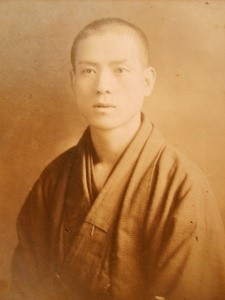
My family name is Yahiro. This surname is already mentioned in the oldest Japanese writings, from the 8th century. Back in those days, in Tokyo, 12 centuries ago, the Palace where the government gathered was called the Yahiro Palace. So probably our ancestors were part of the government apparatus. Then the family moved to Osaka, 600 km away from Tokyo, probably sent there, with the position of foreign minister. At the time I was born, Nara was still the capital for the foreign relations and Tokyo was the capital of Japan.
After that, they became samurai. In 1868 the Samurai era ended, but in the rural areas the tradition remained for a long time. Today the code has disappeared, it is nearly gone! My grandfather was half-samurai, half-farmer. Around the castle there were cultivated lands and he oversaw the peasants/workers and when it was required, he would go to the castle. He was a martial arts teacher, and my father also was a martial arts teacher. He was a policeman and during the war he taught Ju Jitsu and bayonet (Ndr: jūkendō (銃剣道). At the end of the war, because my father was an officer, it was very difficult for him to obtain a job. He passed away at the age of 48. His dream was to travel the world. In fact, I have fulfilled my father’s dream.
Sensei, can you tell us about your mother?
My grandmother’s father was a sake producer from northern Japan. She should have inherited the factory because she was the first daughter and had no brother. On her way to the temple, which was acting as a school at the time, she fell in love with an orphaned monk. My mother was born from this union. My grandmother left her father’s house. They did not marry. My grandmother became a nun herself and lived alone in an abandoned temple for many years, but she did die in my father’s house. My grandfather, from my mother’s side, also became a famous monk in Japan.
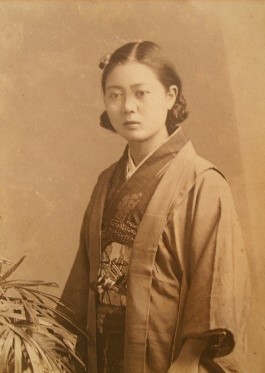
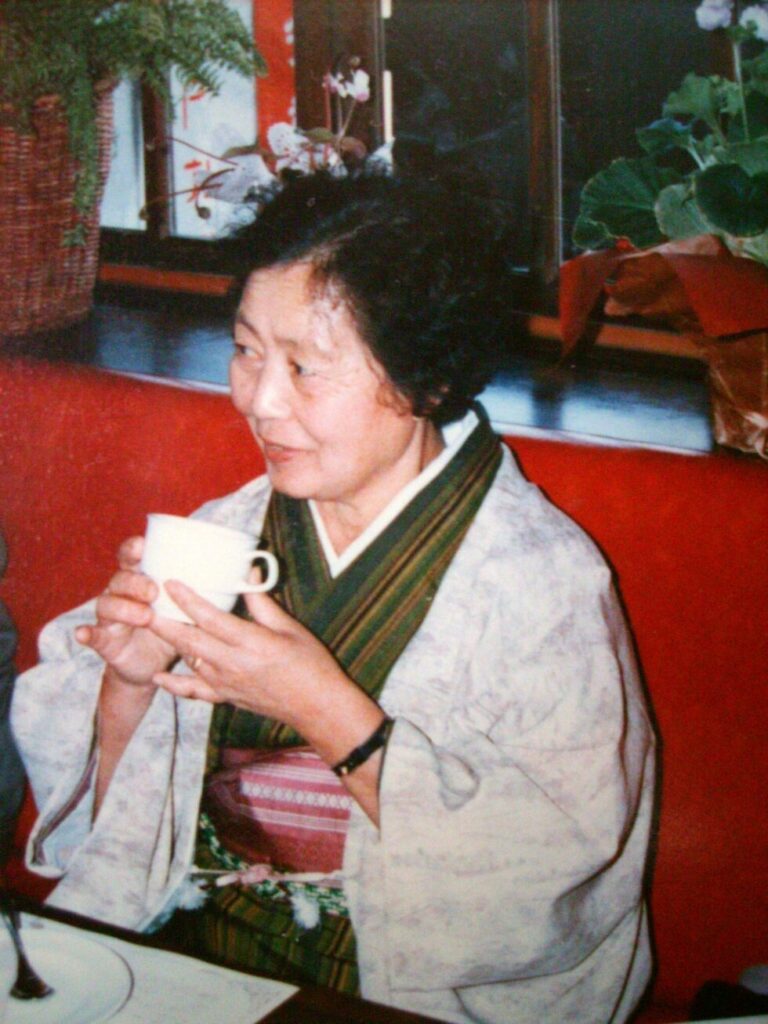
Yahiro sensei’s mother at two very different times. She has always supported him in his choices to seek peace, spirituality and the study of Shiatsu (c) Yuji Yahiro
What is your date of birth Maestro?
I’m starting to get a bit tired with this question!
There is the physical age, the age registered at the town hall (civil age) and the spiritual age. We have different types of age. If you want to know my civilian age, I was born in 1951, on July 4.
Your spiritual age?
I don’t know, that’s the point! I always said 21, as soon as I started to grow up spiritually. When my first daughter reached 21, I added 1 year, so 22 years old as to be at least one year older than her. At 40, I stopped the birthdays, at 50, I reopened the birthdays and was grateful for the life’s gift. Thinking I was sixty, I went to the jungle in India to do a 33-day fast. When I came back, I realized that I had mistaken my age, I thought I was sixty but in fact I was still 58… Anyway, when I came back, my children told me that I was looking younger.
This morning I measured my weight according to my age: I was 60!
So according to the civil registry, my age is 70, my physical age measured against my weight is 60 and spiritually I have no clue!
On a more serious note, my greatest interest is to become a spiritual adult before I die, to become a true human being.
What kind of child or teenager were you? It is said that you were a bit of a troublemaker, is that true?
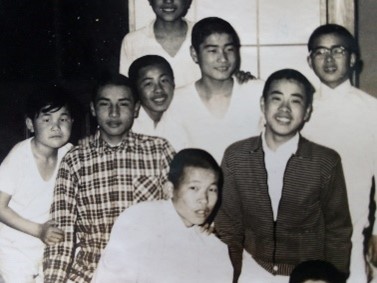
In the post-war kindergarten, there were many children, so my father had a hard time finding a place for me. At the beginning of kindergarten, I was already fighting with everyone and after a few days, I no longer attended. Similarly, in the early days of elementary school, I often clashed with other kids.
But deep inside themselves, those who remember me say that I was kind.
When I was about 9 years old, following an incident which ended up with a lot of blood loss, my character changed considerably, and I became more peaceful.
At the age of 13, you were already practicing Shiatsu and Prana therapy, and you knew that it was possible to help people where Western medicine failed to do so. Can you elaborate on that?
When I was ten years old, my father passed away before my eyes. This was certainly a turning point in triggering something more in me. At the age of twelve, at the end of elementary school, I was appointed as a school representative for 1800 students. Already at that time I felt that school studies were not of any use, that it was not fulfilling me, so I looked for other texts in libraries or bookstores and finally also communicated with a monk living in a shrine. One day, my sister had a headache that would not get away, even with medication. My mother took her to the monk in the temple, and after the monk treated her, the pain was gone. After a while, she suffered from abdominal pain. I recalled that the monk had placed his fingers on her forehead, so I thought I would do the same thing by putting my hands on her abdomen. My sister told me that she felt a kind of electric flow. After that, the stomach pains were gone. That was my first experience with healing. My mother was proud of my natural ability, she was herself practicing natural medicine as an amateur, so she took me to the neighbouring houses, to the hospital, to offer my services to people who had aches. My teachers were the people who had troubles.
The spiritual quest is so strong that at the age of 15 you decided to walk across Japan, what was your motivation?
I made this trip because I was seeking peace in the world.
But to have peace in the world, is just simply walking enough?
Everyone must be at peace. You must begin with yourself. I have been to many peace conventions, but I have seldom seen any peace in the hearts of the people who have attended.
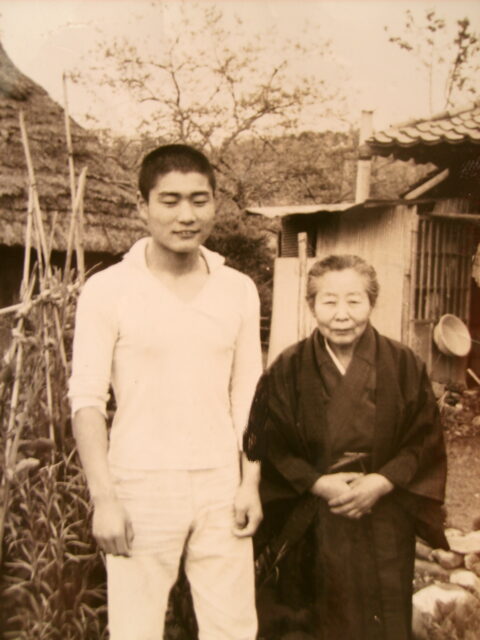
Since you were living in the south, I assume you went north? How long did it take you? As a young teenager, wasn’t it too strenuous to do it alone? What happened?
At that time, many people were already starting to go to college, so my school principal called up my mom and me to discuss. He suggested that I finish school and then carry on the trip later. I said, “Tomorrow my life is not guaranteed, what I want to do now is best if I do it now”. My mother encouraged me in my choice by telling me: “My son is now an adult; I respect his choice”.
On the day of departure, my grandmother and mother bowed to me in greeting. My trip through Japan lasted about a year. I travelled all over Japan.
You went through many wildernesses, forests, how did you sleep, eat?
When there was no food, I didn’t eat, it just meant that there was more time to walk, if you can drink water, life doesn’t die easily. Occasionally someone would also offer me food, a lunch, not too often though. Very often I would sleep in the street, sometimes I was invited into houses, other times I slept in hostels.
One day I was walking, and it was pitch black, I fell asleep and the next morning as I woke up, I noticed that I was in a cemetery. If I had known that I would never have fallen asleep!!!
What happened after this journey?
It was a good experience, lived amid so many adventures, with the support of so many strangers and with so much criticism and reproach from adults. My journey also drew the interest of many university students who would have loved to have had the same experience and who invited me to share how I lived this journey. It was tiring but it helped me a lot. I became more self-confidence.
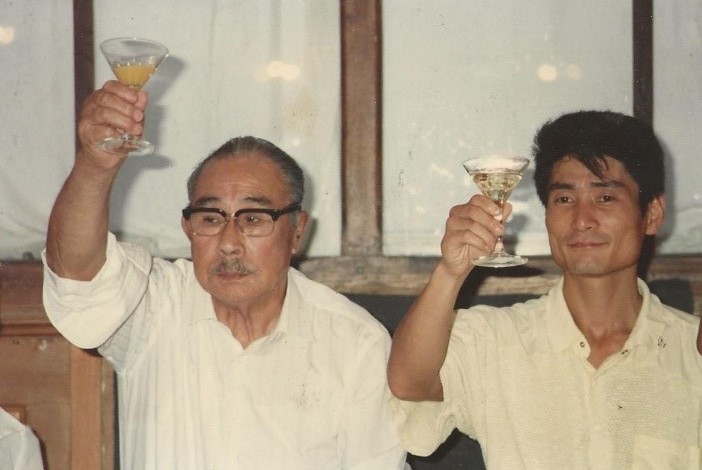
You have been in a Shinto monastery where you have been initiated to various disciplines. What were they?
When I was a child, my family used to go to a shrine founded by Kukai [2], a famous Japanese monk, in the 1700s. So I followed a monk. Basically, the life of this monk was a great inspiration for me. Since my father’s death, a deep interest in the meaning of life had arisen in me.
They didn’t instruct me or teach me any skills; you could say I stole them. The Mikkyo world could be seen as “unteachable”. Those who really want to learn do so without being taught. It is much more challenging, but it is said that “if you feel one thing you will understand it 100 times more”. I was not taught but I learned and at the end the monk gave me a diploma that certifies my skills in moxibustion and alternative medicine, I was 17 years old.
So, for Shiatsu you have not studied classically by going to Tokyo to the Namikoshi or Masunaga school, is that right?
I did not attend any school. I never joined as a student, I had relationships with these people but not as a student.
Clearly this was not enough for you as you left Japan and travelled the world, starting with Australia and then Southeast Asia. Can you talk to me about this period of your life? Did you leave right after your journey?
Not right away, but soon after, because it was not allowed for Japanese transportation to reach freely the rest of the world. In Australia, there was also a kind of apartheid, and it was not easy entering.
When I left Japan with my passport, I could only travel to Hong Kong, Malaysia, Thailand and Singapore. [3]
Why were you interested in moving to Australia?
After my father’s death, I studied various simulations and thought that if there would be a third world war, Australia would be spared.
Can you tell us what you have done there, where you have lived?
When I left Japan, I only had 87 dollars in my pocket. When I went to change money at the bank, the teller asked me, “Are these few coins an addition to a previous deposit?” I replied, “No, this is all I have.” He asked me again, “What is the expected duration of your trip?” My answer, “Minimum one year, if it is possible forever.” I wasn’t so worried about the lack of food, because thanks to my previous experience, I knew that people don’t die so easily. The cashier looked at me with bright eyes and stood up to shake my hand and compliment me. I can’t tell you everything that happened here, but one day I will.
I travelled all over Australia. I first went to Melbourne and then Sydney. In Melbourne, I worked for a Honda branch that sold spare parts. Then I went to work in a Japanese restaurant, I was washing dishes, then I also worked as a waiter and finally as a cook, and cleaning… I was working 20 hours a day, then I had a job in a famous and very luxurious hotel.
In Australia, you started to do Shiatsu, did it work out well?
Yes, I practiced in a clinic behind the hotel where I was employed. We put an ad in the newspaper but as nobody knew the name of Shiatsu, we named it “Nervous Points Massage”…. 15 hours of daily Shiatsu !!!
This reminds me of other masters who came like Kawada in Belgium, Ohashi in America, countries where nobody knew Shiastu and therefore it was necessary to promote it.
Yes, indeed it was like that.
I remember meeting Sasaki San in India in 1971 or 1972. He was in India on a mission about agriculture. I healed him and then he returned to Japan, he attended the Namikoshi school and then Masunaga school before moving to Europe.
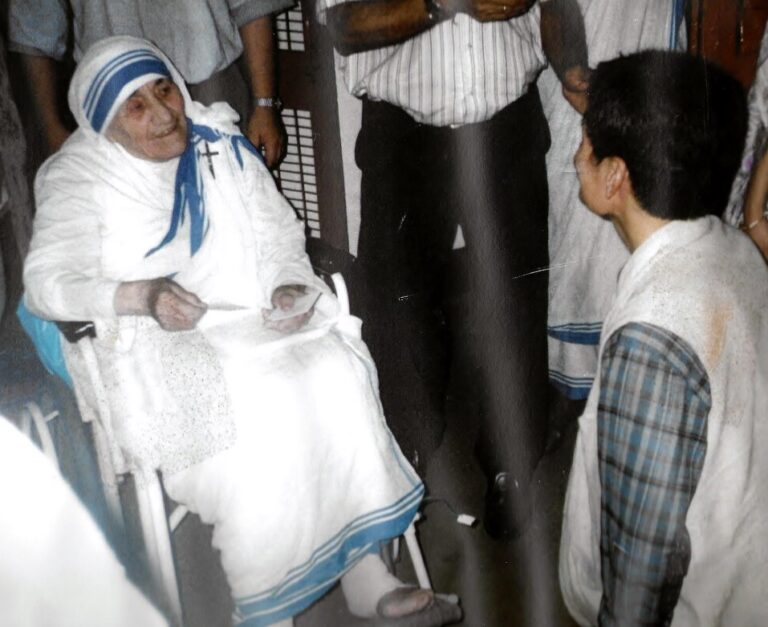
Did you start training people when you were in Australia?
No, I just worked, I didn’t give any training.
I had many jobs and eventually I started an import-export company. For a short period of time, I lived a comfortable life, but then I decided to leave everything to my colleagues. However, these colleagues continued to pay me dividends for next15 years in the hope that I would return one day. When I first entered Australia, it was the apartheid period and only 500 Japanese would be allowed in each year [4]. When I started this business, I was just over 20 and many were surprised at my young age. However, after a short time, I left the comfortable life and moved away.
I wanted to go to South America, I paid for the ticket, but I got conned in Australia, the ticket never arrived. So, I changed my mind and went to Thailand. I opened an import/export company of various products, silk, leather goods….. I stayed in Thailand for almost 3 years.
Do you take advantage of your stay in Thailand to get closer to Thai medicine?
Before going to Australia, I had already been to Thailand and had taught there to 50 Thai massage therapists interested in Shiatsu. I also met an old Japanese man who was also teaching Japanese Amma massage to Thai people. At that time, the classical and serious Thai massage that is now practiced in temples was not well developed. Massage was primarily aimed at tourists for erotic purposes. It was at that time that the Thai people began to take an interest in meaningful massage.
How did you come to Italy?
I first went to Singapore and then via London, I arrived in Europe. And from there to Italy. As I was traveling, I had no intention of settling there.
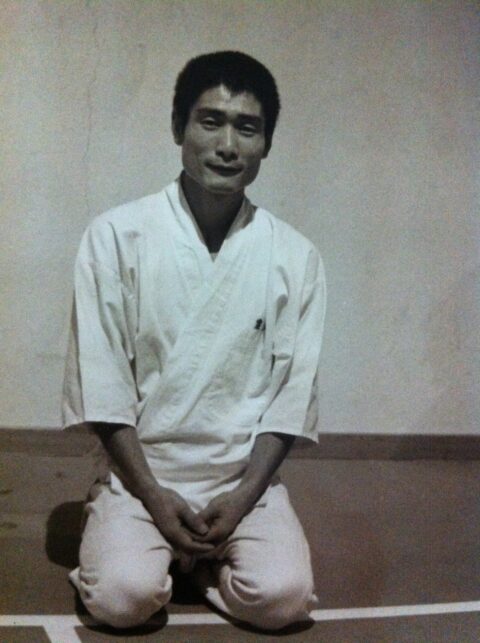
What was the purpose of these trips?
To travel, to discover, with no goal other than to explore.
Finally, you arrived in Italy in 1973. How and why did you choose to settle in this European country rather than another?
I had found a job as a therapist in a private clinic in Switzerland, but I had to wait 3 months before starting. In the meantime, I had decided to go on a trip to India with my brother as he was looking to return to Japan. However, there was an incident with our car which delayed our return to Switzerland. I would have had to wait even longer to work in this clinic so in the meantime I decided to go down to Italy. And by chance in Milan, I met Sensei Deshimaru.
Master Taisen Deshimaru was already a world famous and renowned Zen master. How did you meet him in Italy?
Deshimaru was in Milan for only seven days and I met him on the seventh day. You could say that he was a gift of God. He was holding a week of Zen Seshin at the Judo Busen Center of Maestro Barioli. Many great Italian Judo masters were born here. On this occasion I gave a massage to Master Deshimaru as an assessment. After he received it, he confirmed my abilities and introduced me to Master Barioli [5]. Thanks to Master Deshimaru I started to practice Shiatsu at the Milan’s Bu Sen.
In February 1974 you start to accept patients and in 1975 you begin to do “on demand” teaching at the Bu Sen Centre in Milan.
Bu Sen Centre means ” Specialisation school in martial arts “. Before I was accepted, I had to pass an examination with all the martial arts masters who were at the centre. After everyone confirmed that they were willing to accept me, a judoka had an accident during a practice session. His elbow joint had come out quite seriously. Maestro Barioli said, “Normally I am able to fix a number of incidents, but this seems too serious. Can you fix it with Shiatsu?” I succeeded in fixing it and that’s how Shiatsu started in Italy.
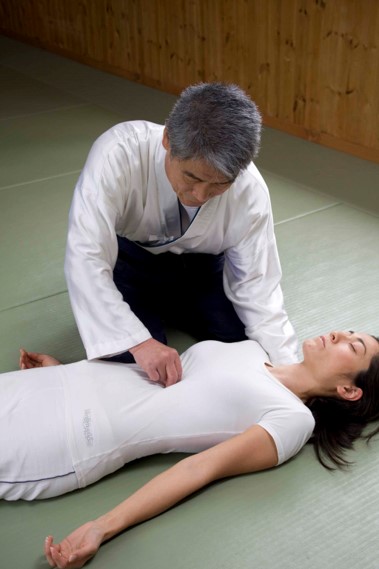
What do you remember about Taisen Deshimaru Roshi?
Many things! There was a great mutual respect, many fond memories… I don’t know which one to start with.
Did you go to La Gendronnière’s Temple, founded by Deshimaru?
Yes of course, he invited me. With him I trained in Zen practice, and he also assisted in my Shiatsu classes. I also had been granted my Zen monk name by Master Deshimaru: Reizen Taijin.
Was Master Deshimaru interested in Shiatsu and manual therapies?
At the end of his life, I was in Spain, working as a teacher for Shiatsu and acupuncture at the Tao Academy in Barcelona and in Madrid. At that same time, I got a telegram from the monk Guareschi, considered the representative of Zen in Italy, I flew to Paris and devoted myself entirely to him for a week. I gave him healing in his centre in Paris, did Moxa, acupuncture and Shiatsu and prepared all his meals. As a token of its appreciation, Deshimaru gave me a book with this dedication. “I had been treated by the best acupuncturist in France, but you, Yahiro, were the only one who could remove my symptoms. Thank you so much for the amazing technique of Oriental Medicine.” While in France, in inside the book I also found a letter written by Master Masunaga to Master Deshimaru on the occasion of the first international Shiatsu meeting held in France a year earlier. In this letter he had written: “In this international meeting, there is no presence of Yahiro who is in Italy. He is still young but smart, please support this boy. Interestingly, I had already met Deshimaru-San and it was thanks to him that I was able to stay in Italy. In the very last week of his life, Master Deshimaru offered to make myself known throughout the world and to use his estate at La Gendronnière to write a book.
So, you have been practicing moxibustion, acupuncture and even nutrition. As far as nutrition is concerned, were you influenced by the macrobiotics of Georges Oshawa [6] and his thoughts on the “Unique Principle”?
I was not introduced to macrobiotics. I was already involved in nutrition. Thanks to the success of Shiatsu treatments, many people came for a cure. At one stage, many of them had similar symptoms. I asked them what they were doing to get better. They replied that they were into macrobiotics. At that time, I didn’t know about macrobiotics, so when I learned that the founder was Japanese, I tried to understand why, despite this philosophy, so many people were still ill. So it was because of those circumstances that I started to study this philosophy and put it into actual practice to understand its effects on myself. As a result, I understood that many of those who followed it only took the most comfortable part of it, that is, they did not had a deeper understanding of it.
You say that people tend to get into macrobiotics superficially, taking only the most comfortable part, what is the deepness of macrobiotics?
All the rest, so many aspects are missing. Most people only study the easy, comfortable side of macrobiotics. I have noticed a partial study; people do not want to get bored. You have to study more, with no fixations.
Another personality with whom you had a close relationship was Shizuto Masunaga sensei. How did you meet him? Most Shiatsu teachers like to say that they were his students, but you were already trained in Shiatsu. So, what was your relationship? Was it a relationship of master and apprentice, or was it more like two researchers exchanging ideas and information with each other? How did the correspondence with Masunaga begin?
I did a lot of work in Milan and the serious cases were constantly rising, so I was looking for the best teachers in various fields to ask for guidance. So, I managed to find Master Masunaga. We exchanged hundreds of communications by writing. We talked more about philosophy than technique. In my opinion, since Masunaga had a degree in psychology, he was more of a philosopher than a therapist. Masunaga replied to me with extensive letters on all subjects in a very thorough way. I have learned from him the behaviour of seriousness, honesty and sincerity. They were not personal correspondence; they were study arguments, and he would post my letters on the bulletin board of his school for everyone to read.
It would be interesting to publish these letters!
Unfortunately, I had stored the letters in a small house that was flooded. I did not check the exact state of their conservation. Now they are stored in the attic and are at your disposal should you want to publish them one day.
As your success increases, you start to have more and more students. However, you decided to leave Milan for the Italian countryside. There you founded the Reishi Kai. What is the meaning of this word?
During my stay in Milan, a thought came to me. On one hand, as my days were packed with patients, I thought that if I had continued like this, I could have achieved worldwide fame, but on the other hand, I had doubts about carrying on with my life in this way. Life is so precious, I thought, isn’t there another way to make it more meaningful?
My purpose is to seek the truth and to become a true Human Being. At the end of this period, I was even invited by a chief surgeon of one of the biggest hospitals in Milan, Dr. Bisiani and his fellow surgeon Dr. Mocchi to work in their hospital. Truth is I was getting prepared to shut down everything and head to the desert or the jungle and stay there forever.
However, God is merciful and at the last moment, I met my current wife, we got married and went to live in her countryside house. I founded the REISHIKAI Association which means “Universal Soul Support”. In doing so, I convinced myself that I had found an environment where I could focus on research without going into the jungle. So, by eating natural plants, practicing meditation and zazen, I was prepared to give up therapeutic approach, but people who had problems kept on coming and I accepted those who came even without money, but this later became a big problem for me; in reality this way of living would not allow me self-isolation.
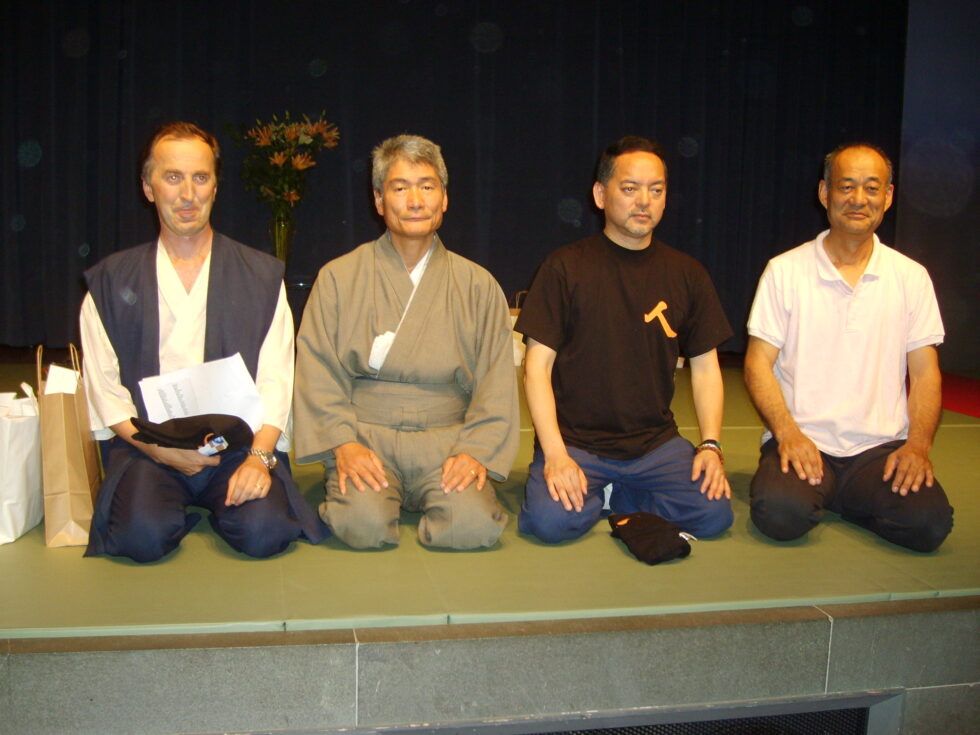
There is also a place of worship in your centre. What is it?
It cannot be called really a “place”. In this world, there are two kinds of education: one is the door of teaching, the other is the door of teaching the “unteachable”. In traditional education, questions and answers are already pre-defined. In the education of “unteaching”, the question is there, but each one must find the answer with his own sweat, as in Yoga and authentic Zen.
The purpose of “non-teaching” education is salvation. Salvation is to be reached through God, and the instrument is prayer and inspiration. For this purpose, a pure heart is essential. Prayer does not mean asking what God can do for you but asking what you can do for yourself. The best example is that of Jesus on the cross who prayed: “Lord forgive them for they know not what they do”.
Today, the place of God in the world of education has been overtaken by science with the artificial intelligence.
Karma, the core of the Personal Being, is made up of memories (DNA), heredity, habits. Nowadays, the field of modern chemistry and physics is significantly more advanced. Thus, we witness that artificial intelligence is beginning to manipulate our consciousness while Chemical based science plays with DNA. To believe in God is replaced by believing in artificial intelligence. But this is not all negative for those who maybe hardly think or feel for themselves as it can be seen as a crutch. In any case, seen from the Human evolution perspective, growth is not guaranteed.

In 1981, you met another figure who would be important for you: Masahiro Oki sensei, a great yoga teacher. As I do not know this man at all, except that he founded his own Okido yoga school and wrote a book on Zen therapy in yoga, would you mind telling me who he was?
In 1981, there was a peace conference in Switzerland. From Japan they invited M° Oki and M° Fukuoka, a world-famous master in natural farming. I was invited to the conference in Switzerland as a translator of M° Fukuoka and thanks to that I met M° Oki. It was my first encounter with these two great characters, and it resonated within me. The one who impressed me the most was M° Oki, it was the very first time in my life that I saw a genuine expression of a human being. So, I decided to follow his “non-teaching”. As of now, before forgetting him, I am writing down all the details of my encounter with him. If you are at all interested, I can send you the script. At this point I am only relating a few moments. He has been sucking the pus of lepers to show his love and then he was also infected. As an advisor, he also met with both Japan’s Emperor and the Prime Minister, but he prohibited making any publicity around those events as not to use them in a mundane way. He did not want to be regarded as a holy professional, but he intended to be a genuine man. He was nominated for the Nobel Prize but refused it.
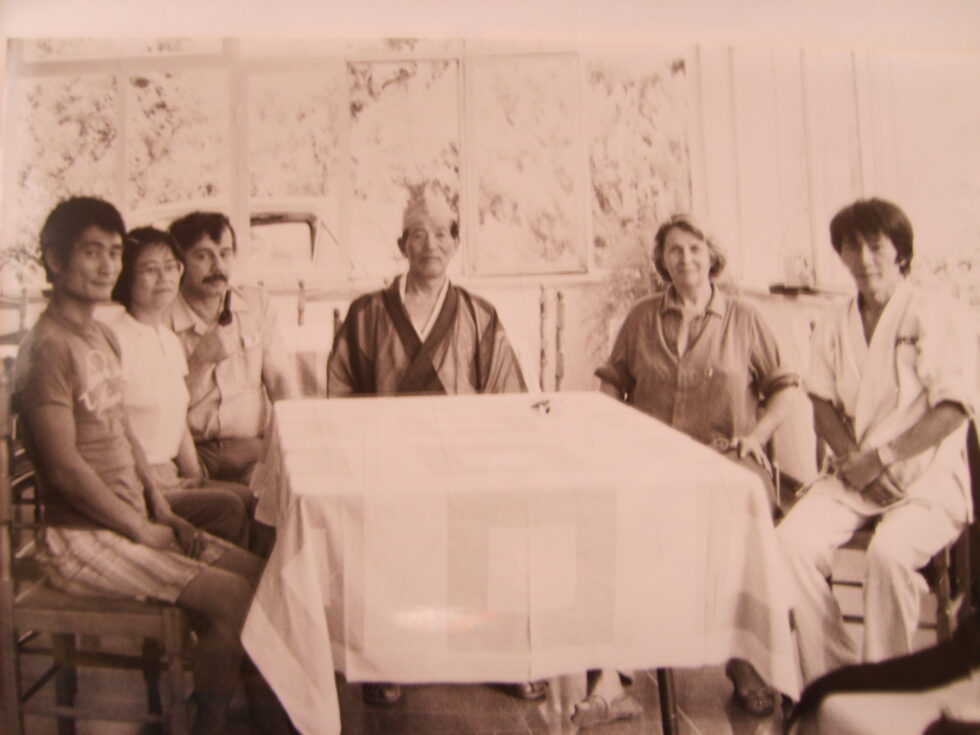
Okido Yoga-San personify the Mikkyo way. In true Mikkyo, there is no heritage. It will end with each generation. Similarly, my commitment will end with me.
M° Oki had his last moment of life here, and I was always standing close to him. He left me a few last words before he passed away:
❖ “I want to pass on all my knowledge to you, but I simply can’t.”
❖ “The truth is, I didn’t really understand anything. This is what I really understood.”
❖ “To create, even small, a group of genuine people.”
❖ “No one will ever understand me.”
After M° Oki passed away, there was a meeting here at the Dojo where the members of the Japan’s headquarter asked me to accept the suggestion that this place become the headquarter of Europe. At the same time, even those who have been cooperating in Italy without any form of organization offered me to make this place also the headquarters of Italy. I rejected both proposals. The reason for my refusal was that I did not want to enter the mundane way of the association, but I gave some advice. For Italy, to create a Federation based in Milan – but without my involvement- to create a school based in Venice and a Publishing House based in Rome. All of this was done to avoid creating factions, but despite my wishes, factions ended up being formed eventually. Feeling the pressure linked to the burden of my responsibility, I decided at that time to depart for the desert, to fast and meditate. After two weeks of fasting only drinking water, I started a week of fasting without water. I collapsed in the middle of the desert and put my life at risk. I was saved by a Bedouin who was walking by. My belief was that if I came back alive from it, it would be a sign that for the rest of my life, I would have a mission to fulfil.
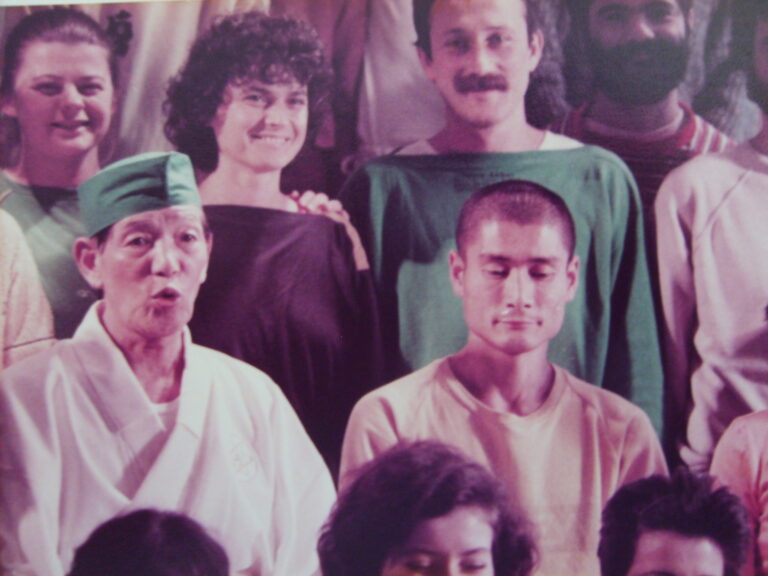
In 2000, I started a campaign to correct the worldliness in the Okido group itself. I failed to do so. Thinking that I was a dreamer, many left, and those who stayed felts again in their shortcomings
In 1982 you published your first book entitled “Keiraku Shiatsu”. Why this title? Why not call it Meiso Shiatsu after the name of your style?
Keiraku Shiatsu was not really a book. At each gathering I was making copies of the written material as a starting point for beginners, so a publisher, to save me the cost of photocopying, offered me to make a printing of it. In fact, I was still doing research and the desire to print a real study text had not yet matured in me. But what I write under the name of Meiso Shiatsu can be considered as the sacred core of my research. I write it to express my gratitude for the feedback Shiatsu gave me in my quest for the truth. I have been writing this for 10 years. It will be a very thorough and in-depth book. In short, a treatise. The draft is ready, and we are finalizing it with the support of the Head of the Meiso Shiatsu Academy, who even if he is not a publishing professional, perfectly understands the content. It will go soon into printing.
This is great news, but can you tell us a bit more about Meiso Shiatsu, from a practical point of view, how have you developed it, what have you put into it?
When those who had learned Shiatsu with me started to spread it, one of these organizations got the idea for their name from me: Shiatsu Do. Later, their business shifted too much towards organizing, so I came up with the name of my group: Meiso Shiatsu.
Basically, Meiso Shiatsu is like an invisible teaching, like the Mikkyo way. It means the key is to feel first and only after you start to look for rationality. It is about setting a principle into action: awareness, breathing, action. It is not a method, but rather a principle that can be used in all areas.
In Zen it is said that there are 3 principles/secrets: the Body, the Mouth, the Awareness.
In any studies there are three deepened processes: Jutsu, Ho, Do
- The first is JUTSU, the technique. The one who goes deeper into the study of the technique, in Japanese is called “tatsujin”.
- The second is HO, the law of nature. The one who goes deeper is called “meijin”.
- The third way is Do, the daily life for the search of truth (“seijin”).
Meditation is necessary to reach this level.
With regard to any subject of study, if one is interested in discovering the truth, one must practice Meiso.
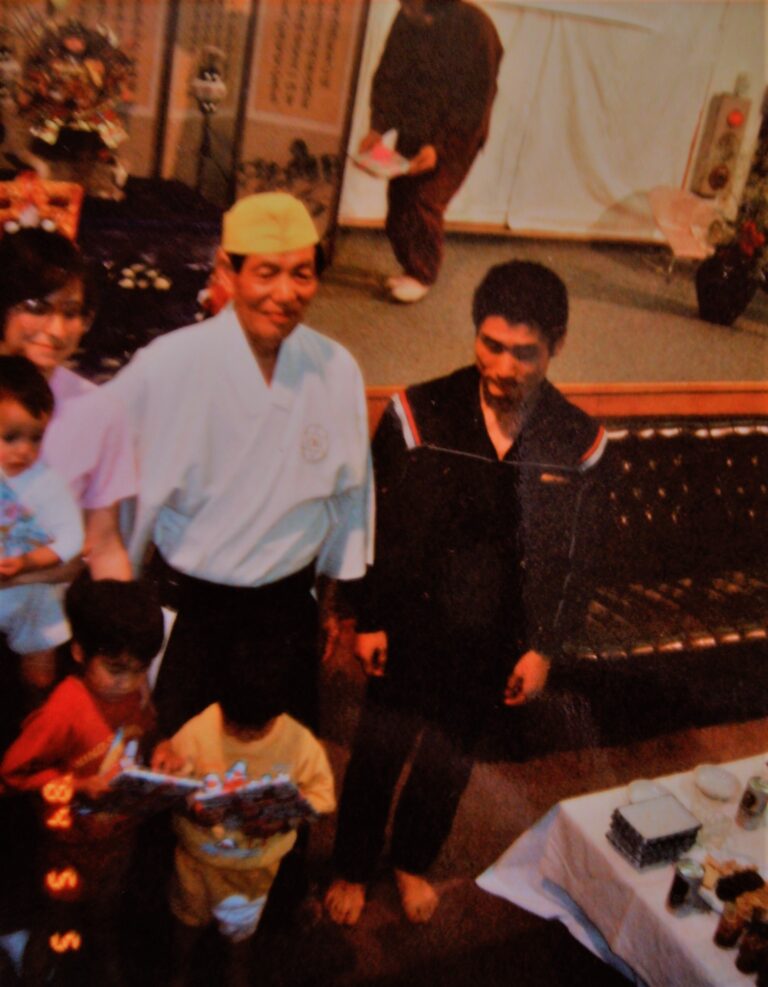
In Meiso Shiatsu, do you make use of the oriental diagnosis? Is there a Kata?
Of course, and in fact those who know how to do a diagnosis are very efficient and experienced!
This Kata exists and the Kenkyo [7] is the basis of the teaching, it is very useful. It is “Jutsu”. You can always improve the technique, but you can’t improve your understanding and your consciousness if you don’t develop the knowledge of “Ho”, the laws of nature.
the Kata is one part of the practical aspect of the physical training, but without listening to the laws of nature, it becomes only mechanical. You can always deepen the technique, but without the comprehension of the laws of nature, you cannot realize the truth.
For example, yoga is very developed in the world, but it is the Kenkyo aspect which is known and not the genuine yoga which follows the Mikkyo way.
Kenkyo’s purpose is about salvation. Man suffers both physically and mentally and seeks salvation through prayer, now through science.
Mikkyo’s aim is to achieve satori, that is, to understand the truth. I am the seeker. With Shiatsu I seek healing from the disease, from the sicknesses. But I must go beyond the illness, to discover the truth, not just to remove the pain. Very often, when I heal, I am satisfied, but I have not learned anything. I must learn from the illness what life is all about. So many people when they get sick, pay to get healed in order to get relief from their symptoms but they don’t take the opportunity to reconsider their way of living, they carry on with their lives selfishly. I looked after a lady with intestinal cancer who was staying at the Dojo with her husband and their four daughters. I therefore accepted them until she recovered with no payment asked. After the recovery was also confirmed medically, they would have loved to extend their stay, but had no interest in the learning process. They were looking at me fanatically as if I was a holy man, so I could not accept them anymore and sent them away. Then, instead of showing gratitude, they slandered me.
I walked away from the therapy world. People value life too little, there is too much materialism. I wanted Shiatsu to be more well-respected and to be a way to worship life more.
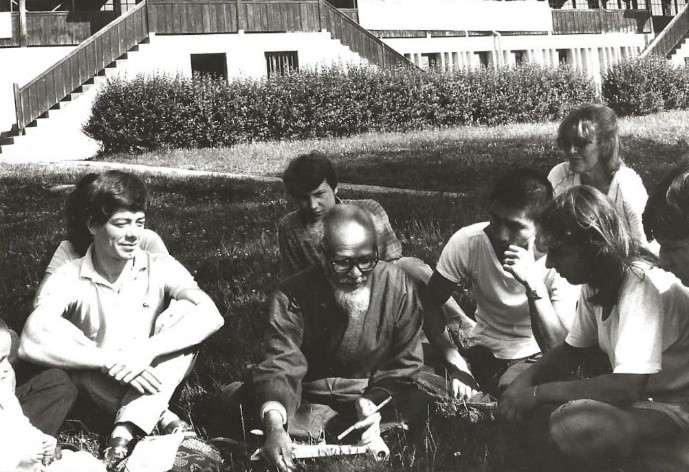
Wouldn’t it be the role of the therapist to raise people’s awareness?
Often the therapist himself is not very aware!
So, what do you suggest as for the therapist to develop his awareness?
With patience! By educating himself/herself in self-awareness.
I have met with thousands of people, but no one is really aware of Shiatsu as a philosophy. Many people are interested in the practical aspects of Shiatsu, but very few are eager to explore the spirituality of the inner side which it can allows.
The Mikkyo community research to learn. The Kenkyo community studies to teach. I do not teach, I study to learn. Studying to learn and then giving is not bad. But it is very difficult. Teaching takes a lot of energy and then there is not enough time to go deeper.
Anyway, we make videos of our katas that work very well. Even when made by amateurs it works!
I did not find any information about you after 1988. We are in 2022, so what have you been doing for the past 34 years?
During all these years, I was a volunteer in various countries such as Morocco, Kosovo, Pakistan and as well in Afghanistan, Myanmar, Cambodia, India. Several times I was invited by the Kiev Astronautical University in Ukraine.
In India, I had several meetings with the spiritual leaders of Jainism and the dean of the Jain university. I was invited several times by the president of one of the most popular publishing houses in India, Rajastan Patrika, for a peace conference. I met the former Prime Minister of India three times. Some of the “Life Stories” I sent to you were published in this newspaper all over India. Their chairman would have loved to have made me known all over India, but I also declined this offer. Two years ago, he wanted to publish my picture after 49 days of fasting, I also declined.
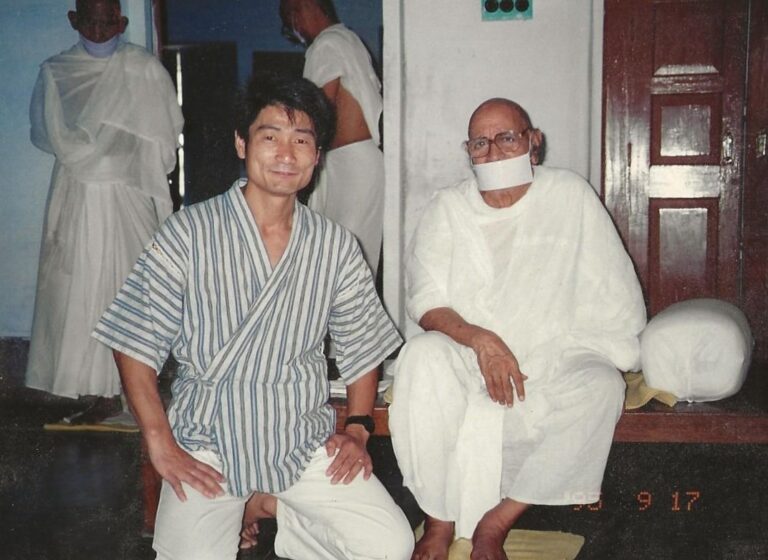
Since you are a specialist of the Shinto religion, I would like to take this opportunity to ask you a philosophical question. In the Shinto religion we say “Ichi Rei Shi Kon”, translated “one spirit, four souls”. Can you explain the meaning of this sentence quoted by O Sensei Ueshiba, the founder of Aikido?
There is no exact translation of this sentence outside of its Japanese meaning: “Ichi Rei Shi Kon”. One soul, four characters. We could say that the first is happiness, the second is courage, the third is perceptiveness, the fourth is peace. Master Onisaburo Deguchi [9] was the spiritual master of Master Ueshiba. I met the grandson of Master Deguchi, one of the most famous monks in Japan. When he heard that my wife and I got married without a religious ceremony, he suggested that we celebrate our wedding 10 years later according to the Shinto ritual. On this special occasion, he made me wear the robe of his grandfather, Master Deguchi, as an exception.
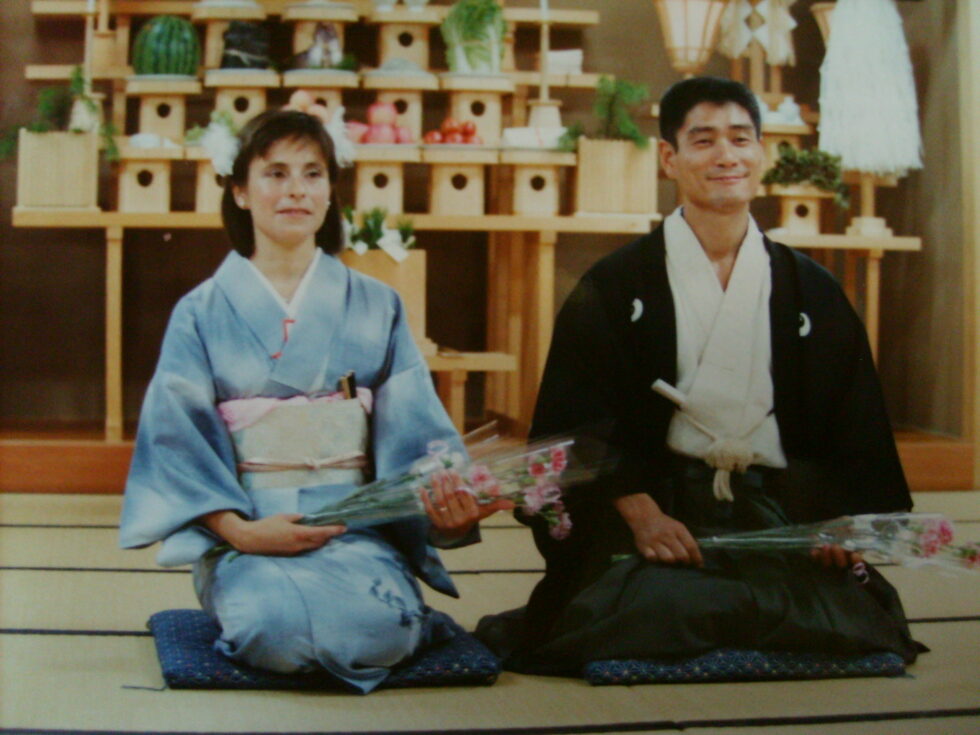
(c) Yuji Yahiro
Thank you very much for your explanations. Master Yahiro, do you have a message for Shiatsu practitioners? (Yahiro Sensei then took a long moment of reflection in which one could feel that he was searching for the right words to best convey what he wanted to share).
I would like to talk about the encounter and conversation with Life and the universal blissfulness.
When I was 10 years old, I had a dream full of colours. In this dream, I learned that my father had died. I wandered around the world in search of the herbal medicine of Immortality. Finally, I reached a majestic mountain range, like the Himalayas. This imposing mountain was black in colour, without snow. At the top of this divine mountain, there was a white flower, pure and brilliant, but it was a close call as to grab it. I look at the world beneath me: only a deep chasm. So, I am convinced that my father is dead and I descend from the mountain weeping. After this dream experience, I devoted my life to the quest for this white flower and made it here. One of these flowers is the Shiatsu universe. This bright white flower is the symbol of life.
Having a dialogue with this life is the prayer. To be united with Life (God) is an ongoing meditation and a universal joy. This is how I understand it now. The Life entity which manifests itself as a person is made through the body, the heart, the soul, the social life and as well the environment of our planet and the universe. The planet’s environment and human society have always undergone enormous changes, both through natural disasters and unnatural events such as man-made wars. Modern education is based on scientific research, especially physics and chemistry have become extremely developed and widespread. We are witnessing a major conceptual and knowledge shift in our understanding of the environment and life, which is dominated by the digital technology control.
According to a modern physical science theory, when neutrinos are released into the atmosphere, they are split into neutrino-electron (matter) and anti-neutrino-electron (antimatter), which then collides and disappears. But actually, some of them remains. This is, according to scientists, a hypothesis for the existence of matter and antimatter. The size of these neutrinos, if one compares the atom with the planet Earth, is that of a pinhole. Prana particles are even smaller than neutrinos and are invisibly present in great quantities in the whole universe.
The meaning of karma is memory, legacy and habit. When life manifests itself through a person, it reflects his or her influence and at the same time it resonates with the environment and society and thus manifests the individual character. The technology of Artificial Intelligence and genetic engineering has now penetrated the human territory of Karma, the fundamental essence of Man, its memory and legacy. According to Meiso Shiatsu, the world of awareness can be divided into 32 stages. This generates hatred and conflict, but it also generates the natural body, i.e. health, and the genuine heart, i.e. happiness. Thus, the world of peace and freedom is also created in the end. But this condition is not automatically generated at it only happens with education.
The key lies in the three principles of Meiso Shiatsu. The path to true health, true happiness, true freedom and true peace.
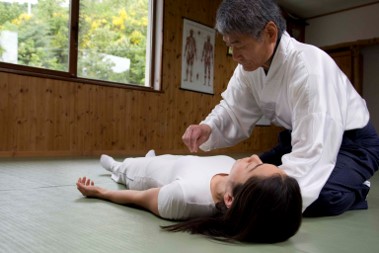
There are two types of teachings:
- Education by teaching, which was created for the humankind living a social life
- Non-teaching education, which is learning Satori, created to uncover the truth.
The ordinary society does not make the truth visible. The truth must be thought scientifically, philosophically and religiously. To achieve this, scientific research must be comprehensive and not partial, philosophy must be practical and not just an observation, and religion must not be an ideology but be lived through a way of life that advocates “one person, one religion. The three principles of Shiatsu are the same as those of non-teaching education. I have great admiration and respect for the doctor who discovered these three principles.
The three principles of Shiatsu are:
- The perpendicular pressure is the pressure of the breath.
Many have misunderstood Shiatsu to be finger pressure, but if this was the case, not only would the fingers be harmed but also the body. Instead, the correct pressure is the pressure of the breath applied by the hand. The key is that the Shiatsushi has a longer breathing than the patient. Those who have been practicing at a higher level through apnea mature the Ki and can obtain a greater impact. When you are well trained, you can also do remote therapy. When the pressure is at a perpendicular angle you can aim it at the centre of your target.
- Constant pressure is called Tanden pressure (abdominal and lumbar force)
Consistent pressure results from the strength of the abdomen and lower back. The pressure of the hand or fingers, if it is not inferior to the strength of the tanden, does not reach the inner target. One of the characteristics of Shiatsu is the stimulation of the para-sympathetic nervous system. This is performed through the strength of the tanden.
- Focus (“supporting pressure” according to Masunaga’s method) is the pressure of Prayer (dialogue with Life) and Meditation (union with Life).
This is the pressure of the human heart. With a conscience having a heart which can honour other people, able to forgive others and express gratitude. A heart capable of highlighting the worth. What to do to express it? This is the power of prayer. Finally, with this dialogue, the union with life is called meditation. It is the pressure of the ode to life, that is, the pressure of universal joy. We are all children of the universe, that is, children of God. Be grateful to life, try to think of how it is better to live so that life itself can be pleased. Ask yourself, “Life, through that pure heart, in what kind of expression throughout the body does it desire me to do?”
There are many approaches to health, but basically there are three types of healing:
- Enforced healing
- Natural healing
- Healing without any interference
Enforced healing means that one has no interest in changing one’s habits, in correcting one’s body or in adjusting one’s way of thinking or living. You only want to change what is wrong. Natural healing means correcting the physical balance, adjusting the balance of the state of mind. Healing without any intervention implies finding the purpose of life and trying to live in a way that makes life itself happy. From there, if necessary, you can also step in. I wish you could put into practice a correct way of studying Shiatsu.
Amid this world chaos, live a life that is worthwhile.
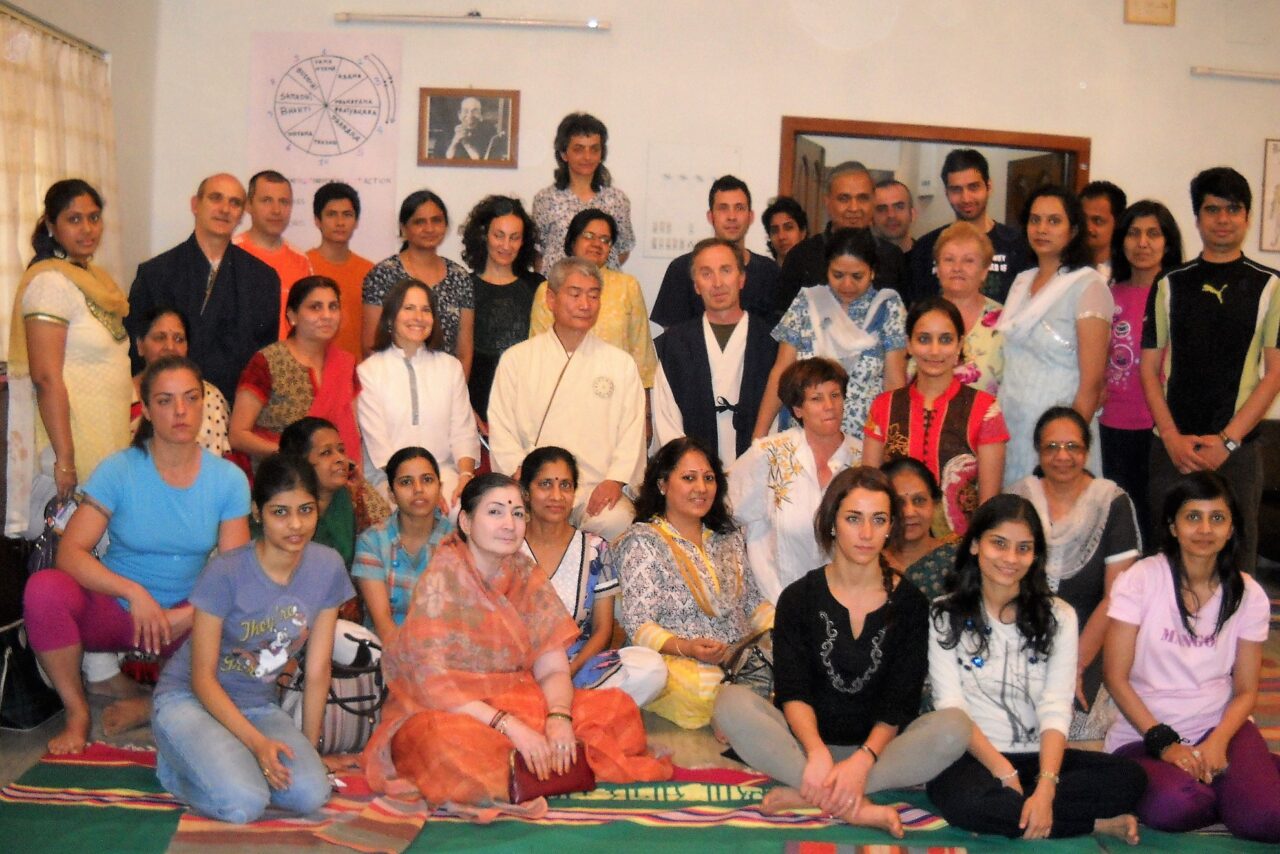
A huge thank you Master for this wonderful message and thank you very much for taking all this time to share your message with us.
Author: Ivan Bel with the precious help of Nathalie Durand
Translator: François-Rémy Monnier
Notes:
- [1] Minoru Mochizuki (望月 稔; 1907-2003) was one of the greatest martial arts masters of his time. A direct student of the founder of Judo (Jigoro Kano) and the founder of Aikido (Morihei Ueshiba ). During his career, he was 10th dan in aikido, 9th dan in jujutsu, 8th dan in iaido, judo and kobudo and finally 5th dan in kendo, karate and jo-jutsu. To learn more about him, read “The Story of the Japanese Pioneers of the 1950s″ (french only).
- [2] The monk Kūkai (空海; 774 – 835), better known as Kōbō-Daishi (弘法大師), is the founding saint of the Shingon school of Buddhism; he is also a prominent figure in Japanese history: his universal spirit strongly influenced Japanese culture and civilization. He was not only a great religious man, but also an eminent man of letters, a philosopher, poet and calligrapher.
- [3] After the war Japan was under strict occupation by the United States. Among the various measures related to the occupation was the restriction of foreign travel for all Japanese.
- [4] In 1901, one of the first acts of Australia as a nation was to introduce the so-called White Australia policy to exclude non-Europeans from the country. As part of this policy, Melanesian slaves and their families were forced to be resettled, breaking age-old family and trade ties between Aboriginal Australians and Indonesia. It was not until 1965 that Australians began to react against this policy, which extended to all non-whites.
- [5] Cesare Barioli (1935 – 2012) was an Italian Judo master and pioneer of the 1950s. Passionate about Judo, he found the writings of Jigoro Kano and translated them into Italian.
- [6] To learn more about Georges Oshawa, founder of macrobiotics, read the article , read “The story of the Japanese pioneers of the 1950s″ (french only).
- [7] Kenkyo (謙虚) means “humility” or “being humble”.
- [8] Acharya Tulsi (1914 – 1997) was recognized as Ganadhipati, i.e., the Superior of all Indian monk-ascenders in our era, a title never conferred until now. He worked hard to make sure that everyone had the scriptures of Jainism at heart and applied its values.
- [9] Onisaburō Deguchi (出口 王仁三郎; 1871-1948) was a Japanese religious man considered the second spiritual leader of the Ōmoto movement. He was a prominent spiritual figure in pre-war Japan.
Yahiro Sensei’s books (in Italian)
- Keiraku Shiatsu: Red edizioni, 1982
- Meiso Shiatsu. Terapia e educazione per la salute e l’evoluzione umana: Cometa, 1994
- Okido – per apprezzare il valore della vita: Edizioni Mediterranee, 2012
- A Milestone: The 2025 ESF Symposium in Brussels - 24 March 2025
- Austria – 19-21 Sept. 25: Shiatsu Summit in Vienna – chronic fatigue, burnout & depression - 19 December 2024
- Terésa Hadland interview: Shiatsu at core - 25 November 2024
- Book review: “Another self” by Cindy Engel - 30 September 2024
- Austria – 24-26 Oct. 25: Master Class in Vienna – Shiatsu and martial arts - 20 August 2024
- France – Lembrun Summer Intensive Course – July 6 to 12, 2025: Digestive System Disorders, Advanced Organ Anatomy, and Nutrition - 4 August 2024
